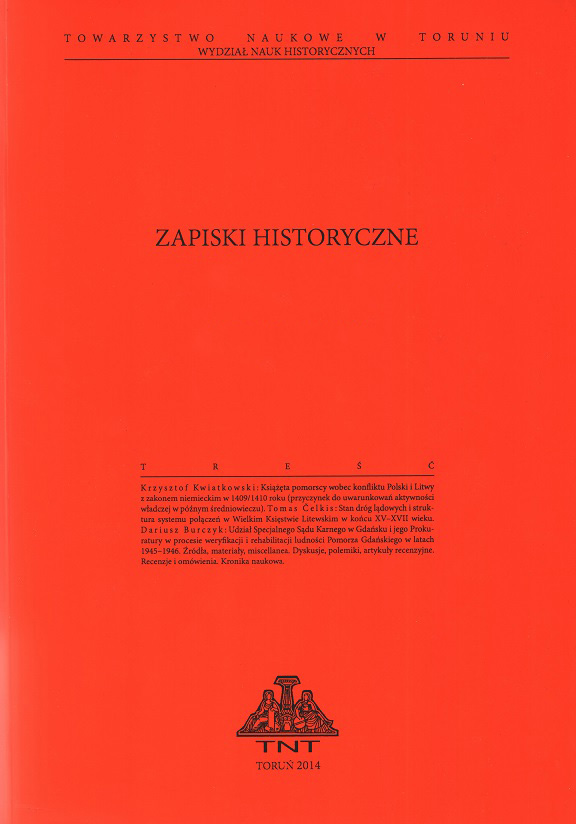Miasto na pieczęci
The City on the Seal
Around the Visuality of City Seals from the Area of Prussia
Author(s): Marcin HlebionekSubject(s): Cultural history, Diplomatic history, Middle Ages, History of Art
Published by: Towarzystwo Naukowe w Toruniu
Keywords: city sigillography;towns;Prussia;identity signs;visuality;
Summary/Abstract: The visuality of the seal, as expressed in the title of the article, should be understood as a collection of stamp elements received by means of wax. Consequently, they will include not only the image of the seal and the caption, but also the shape, size and colour of the wax in which the imprint was made. All those elements can transfer important information from the point of view of the owner, expressing their individuality. Two groups of factors have had an impact on the visuality of the seal: legal and cultural factors. The first group of factors defined the sigillographical system of the owner, but they could also indicate the circle of persons deciding on the shape of a particular seal, or they could directly refer to the form of imprints. The second groups of factors influenced the shape of the message on the seal recorded in both the verbal sphere, iconography and in the form of prints. Among the city seals from the area of Prussia, round seals prevail; their diameters range from 80 to 30 mm. They were usually imprinted in natural wax, green or, less often, black. Only Gdańsk and Toruń were allowed to use red wax under the special privileges granted by the monarchs. Captions included in the seal were usually formulated in Latin, although the names of towns were usually written in German despite the existence of their Latin counterparts. Imaginary ideas, in the context of the typology proposed by Toni Diederich, mostly represented the symbolic type, although a significant percentage of them constituted the canting arms and coats of arms. Other types appear less often. However, the complexity and ambiguity of messages written on the seal by means of images means that any attempt to include them in the typology framework results in the simplification of interpretation. That is why, the research of city seals based on the assumption that they represent the urban self-awareness – the sign of the center’s identity (Brigitte Miriam Bedos-Rezak) becomes more and more significant. In this context, information provided by the visual side of the seal can be reduced to three sets of messages: presenting the city as a topographic space, presenting the city as a social space and presenting the city’s relations with the surroundings. The name of the city determined the town’s definition as a settlement point, which we encounter in legends, but also the notions of canting arms frequently found in Prussia (e.g. Sepopol, Orneta, Allenburg). Seals with the images of walls and urban buildings (e.g. Malbork, Cynty, Toruń) showed the city as an organized space. Paradoxically, the images of wild animals, extremely popular in Prussia, which combined with the legend identifying the owner as a city, showed what the city was not. It is in the seal’s legends that we find the most frequent reference to the city as a social space. Determining the main seals as sigillum civitatis, burgensium, civium, Borger, indicates that the owner of the seal maker was the community of residents. The language of the caption indicates the cultural embedding of the commune. In turn, the size and material of the print inform about the real significance of the center, or about the aspirations of its inhabitants. In connection with the legend, it sometimes brings information about the place occupied by the seal in the urban sigillographic system, which is often derived from the structure of municipal authorities. The images shown on the seal, in turn, refer to the devotion of the commune (e.g. Brodnica), or professions of its residents (e.g. Pieniężno, Młynary, Elbląg, Gdańsk). Through the images representing the city walls or the arms, they finally illustrate the readiness of the inhabitants to defend themselves (e.g .Toruń, Malbork), or they indicate that the urban community had its defender (Chełmno, Pasłęk?). Many of the seal’s images from the Prussian region refer to the city’s relationship with the broadly understood surroundings. By showing the coats of arms (Bisztynek, Malbork), symbols (Toruń, Gardeja, Lidzbark Wamiński), or insignia or attributes (e.g. Reszel, Barczewo, Fischhausen) of a land master or his representative, the seal indicated the owner of the center. In this context, particularly interesting, but also poorly recognized are the links between the iconography of city seals and the images of the seals of the Teutonic officials (e.g. Święta Siekierka, Górowo Iławckie, Radzyń Chełmiński). Finally, the hagiographic seals indicate the relations of the urban community with the supernatural world (Frombork, Pieniężno, Sztum, Gierdawy, and Toruń). The example of the Frombork seal shows that all these meanings can interpenetrate, contributing the creation of a complex image of the city represented on the seal.
Journal: Zapiski Historyczne
- Issue Year: 84/2019
- Issue No: 1
- Page Range: 85-121
- Page Count: 37
- Language: Polish

